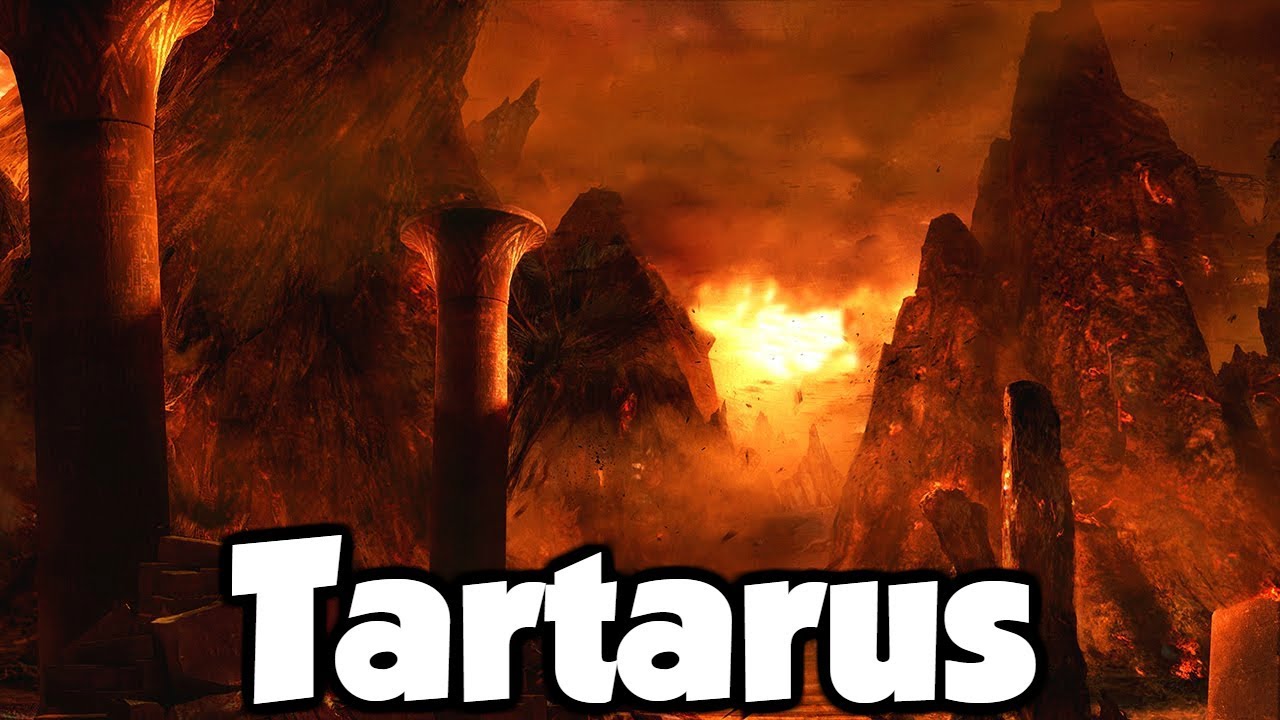Tartarus the God
Tartarus is initially mentioned in Hesiod’s Theogony (8th-7th century BCE) where he is depicted as one of the primordial deities along with Chaos and Gaia. Hesiod describes Tartarus as the third god to exist prior to the foundation of time itself. Tartarus, along with his sister, Gaia bore the monster serpent Typhon. Though in other writings of Greek mythology, Typhon is said to have different parents, such as Cronos or Hera. However, Typhon is generally associated with Gaia and Tartarus since that is the original reference of his parentage.
Typhon will be part of a future blog post on the theology of Chaos from Creation since it does have a significant intersection with the theme of the abyss/hell. As for the serpent god, Typhon is occasionally described as having 100 heads and occasionally 50 heads. He is always depicted, though, as a terrible and frightening monster who is eventually thrown into Tartarus. Similarly, Typhon can be associated with the primordial chaos beasts in other ancient religions such as Leviathan, Tiamat, Lotan, and Yam. There will be an association between this concept of chaos and hell in a blog series on Revelation because of the similarities with the beast being thrown into the Lake of Fire. I will attempt to write about that shortly because it is a very captivating narrative.

Transition of Tartarus
Tartarus the place is extensively known throughout Greek mythology. It is comparable to our contemporary understanding of the traditional form of “hell” with fire, punishment, and torment for all who end up within its gates. It is unclear when the transition began of Tartarus from god to place of punishment. However, it appears to be relatively soon following Hesiod’s Theogony because of a lack of narratives about him as a god and any form of meaningful exposition.
Tartarus the Place
Tartarus is almost always associated with a prison that has large bronze gates guarded by the hecatoncheires (giants in Greek mythology with 50 heads and 100 hands) and can only be opened by one who holds the key to the prison. In Theogony, Tartarus is depicted as “far beneath Hades, as Heaven is above the earth.” Hesiod goes on to characterize the location of Tartarus by declaring that it would take a bronze anvil nine days to fall from heaven to earth and then nine more days to fall from earth to Tartarus.
Similarly, in Homer’s Iliad, Zeus states that Tartarus is as far beneath Hades as heaven is above the earth. Likewise, the mythographer Apollodorus declares, “a gloomy place in Hades as far distant from earth as earth is distant from the sky.” Accordingly, these references to Tartarus demonstrate that it is a deep, dark place equivalent to the abyss that functions as a prison and/or hell for whatever entity is cast within its gates.
First into Tartarus
Throughout the infamous battle known as the Titanomachy in Greek mythology, the Olympians overthrew the gods who were currently in power, the Titans, and banished them into Tartarus. However, some Titans were spared that final destiny and Cronos, who was initially cast into Tartarus, was forgiven by Zeus and eventually became the ruler in the Greek “heaven,” Elysium. This is the first allusion we know of that sees Tartarus as place of punishment. It evidently remains that way for the remainder of any narratives about its functionality.
In Plato’s Phaedo, the philosopher illustrates the fate of humanity in three distinct manners. First, the individuals who lived a “neutral” life, meaning they are neither good nor wicked, are first sent to the Acherusian Lake located within Hades. This lake is a place of purification for the neutral individuals sins, which appear to constitute the majority of the population after death.
Second, the evil sinners, who are deemed “incurable,” are delivered to Tartarus for eternity. These individuals are the murderers, rapists, and evil persons who are to be tormented in Tartarus forever. Those that fall into this specific category, who have committed “lesser” sins, (e.g., fighting or theft) are sent to Tartarus for an entire year before they are dispatched to the Acherusian Lake for purification. Interestingly enough, it is here that they can cry out to those they have harmed, or sinned against, and plead for forgiveness. If those who were sinned against forgive those in Tartarus, the prisoners can be released from their torment. The last group is the extremely holy people who bypass all punishment and purification processes and go straight to Elysium. No need for any purification. Of course, not many would fall into this category except the religious leaders or kings.

Religious Texts
Tartarus is mentioned throughout ancient literature independent from Greek mythology. The book of 1 Enoch, for example, describes Tartarus as a place where the wicked angels (Nephilim) are sent to be punished and locked in prison. The angel in 1 Enoch, Uriel, is said to be the one “over the world and of Tartarus,” and is the one preserving the angels in their prison. The author of 1 Enoch appears to take the “prison” motif from Greek mythology and apply it in Jewish literature to demonstrate what happened to those rebellious angels in Genesis 6. Similarly, 1 Enoch expands significantly upon the short Nephilim stories from the Bible and becomes the foundation to the “Book of the Watchers” (the first section) in 1 Enoch.
Apocalypse of Peter
Another non-canonical book, “The Apocalypse of Peter,” is thought to contain the word Tartarus when the author writes about hell. However, we only have fragments of that book in Greek and only have a full extant copy in Ethiopian, so we do not precisely know what Greek word was used for hell. Despite this, the name of the angel in the Apocalypse of Peter, similar to Uriel in 1 Enoch, is named “Tartaruchus,” which means “holder of Tartarus” or “the one in charge of Tartarus.” It would seem implausible that Tartaruchus would be the one in charge of Gehenna if that was the original Greek word employed in this apocryphal book. Therefore, it is safe to claim that Tartarus is the Greek word in that apocalyptic text.
What is remarkable about the Apocalypse of Peter, however, is that it is a thoroughly Christian book written around 135AD and does not use the word “Gehenna” for hell. D. D. Buchholz, who wrote his Ph.D. dissertation on the Apocalypse of Peter, states that the author must have utilized the Gospel of Matthew as a source for much of his material. Since Matthew’s Jesus uses the word Gehenna 7 times, and the author of the Apocalypse of Peter uses Matthew as a source and writes extensively about hell, would he not use Gehenna if Gehenna was intended to suggest hell? This will be a blog post later because it is an incredibly significant issue. However, in this writing, it appears evident that Tartarus is instead used as hell.
Tartarus in Canonical Scripture
Curiously, Tartarus is also mentioned in the Christian New Testament, in 2 Peter 2:4. This is explained further in my blog post about the words of hell found HERE. In that post, I write a significant amount more about how the word “Tartarus” is used in its lone instance in scripture, so I will not go into too much detail here. But suffice to say, Tartarus is only used once by the author of 2 Peter and is one of the reasons that 2 Peter is so controversial among scholars concerning its canonical status. Another reason is the apparently detailed comparison to the Watchers narrative in 1 Enoch. There is no doubt the author of 2 Peter was at least aware of the Watchers in Enoch when he says, “For if God did not spare angels when they sinned but sent them to hell (Tartarus) putting them in chains of darkness to be held for judgment.” Though many disagree, this reference appears to corelate 1 Enoch with Scriptural authority.
Again, if Gehenna indicated hell, why would Peter, Jesus’s best friend, use Tartarus when Gehenna would be the obvious choice? Why would he reference 1 Enoch in a manner that appears to legitimize its contents? Obviously, we do not have the precise answers for these questions, but it is noteworthy nonetheless.
Conclusion
Like anything relating to the history of hell and Greek mythology, so much can be said that an entire book could not cover. However, this is a good overview of Tartarus that should be enough to pique anyone’s curiosity about why it is used in the Bible and for what specific context.
Previous blog post on Hades is found HERE
Next blog post on Sheol is found HERE
Further Reading:
Bernstein, Alan E. The Formation of Hell: Death and Retribution in the Ancient and Early Christian World. Ithaca, NY: Cornell University Publishing, 1993.
Papaioannou, Kim. The Geography of Hell in the Teachings of Jesus. Eugene, OR: Pickwick Publications, 2013.
Turner, Alice K. The History of Hell. New York, NY: Houghton Mifflin Harcourt Publishing, 1993.
World History Encyclopedia. https://www.worldhistory.org/Tartarus/


